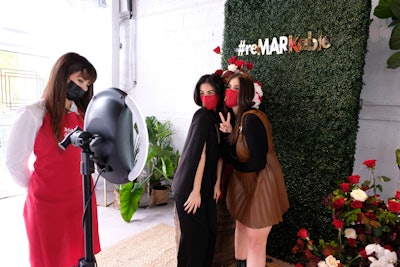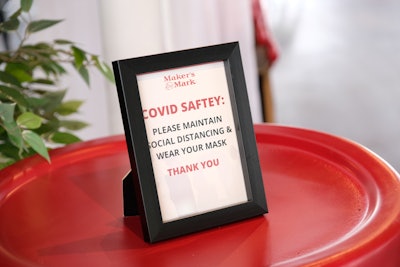
There are a lot of things to think about when planning live events during COVID-19. But one that can't be neglected is that many attendees may have a certain level of anxiety about gathering in groups—regardless of how compliant an event is with CDC regulations. Take these concerns seriously, and ease their fears with the following tips.
1. Clearly communicate safety measures—but don’t make them all an attendee thinks about.
Your attendees and your staff need to know that their safety is being taken seriously—though Eric Holmen, chief revenue officer for event marketing technology company Splash, says there’s a fine line between communicating safety measures, but also not making them the only thing an attendee sees when they look at event’s invite, webpage or marketing materials.
“They want to know that you're on top of it, but they don't want it in their face the whole time, to constantly be reminded of the pandemic,” Holmen says. He suggests outlining basic safety measures in pre-event communications and then giving attendees the option to learn more via an additional website, an FAQ page or even a staffer to contact directly. (Want to learn some best practices for pre-, onsite, and post-event communications? Check out Splash’s recent white paper on The Return to In-Person Events.)
“It’s about finding that balance,” Holmen notes, adding that follow-up communications no longer need to dive into every safety measure. “Personally, I’m a person who would want to know more details. But once I do know more and I’m satisfied, when I go to the next piece of media or the next page on the website, I don't want to see [the safety procedures] all over again. Now I want hear more about the event itself.”
2. Be consistent with your messaging.
“Whether you have a landing page on a website, or are sending email invites to guests, it is crucial for the messaging highlighting the safety precautions to be consistent across the board,” say Katya Bravo and Yoana Obregon, the founders of Miami-based creative marketing agency Secret Sauce. “By sharing any pre-event communication, it will also help gauge the interest of potential attendees and give them the confidence to attend—especially when sharing the precautions and steps that will be taken during the event to ensure guest safety.”
3. Make it clear you're following all laws and CDC guidelines.
An important way to keep guests feeling confident? Show that you’re up to date all the latest federal and local laws on mask requirements and capacity restrictions. “You can naturally create an environment that feels safe by managing a certain percentage of capacity,” say Bravo and Obregon. “Following federal laws and CDC guidelines by enforcing masks and providing sanitation stations will also help guests feel comfortable."
It’s also important to learn and communicate the rules on a local level. “A lot of different jurisdictions are managing things differently,” says Holmen. “New York is talking about a vaccine passport, for example, while other states have already said they’re not going to do that.” Different types of venues, like city-run sites versus private businesses, are also likely to have different sets of rules. Make sure you and your entire team are up to date on all the regulations, and be ready to answer attendee questions. “Being able to communicate what those are and that you're compliant with all local jurisdiction is going to be really important,” he says.
Similarly, consider venue characteristics like filtration systems, outdoor space, and cleaning processes—and make those details clear to attendees. (Related: 7 Questions Event Planners Should Be Asking Venues in a COVID-19 World)
4. Make sure attendees are aware of any screening procedures before they register.
Whether you’re requiring proof of vaccine, rapid COVID tests, and/or health questionnaires and temperature checks, make sure attendees know that right off the bat so they can determine what they’re comfortable with—and what they’re prepared for. “That way if somebody is registering, they don't go in with the wrong assumption about what they're going to have to prove when they get there and won't have to prove it in advance,” says Holmen.
While so-called vaccine passports have become a hot-button issue, be prepared to defend your choices. For his part, Holmen thinks that attendees will be expecting health screenings and temperature checks at the very least. “When I go to the gym and my temperature is checked on the way in, I’m a little more confident knowing that everyone else in there has also had their temperature checked,” he says. “We're learning those behaviors already, so I think we can extend those into our events—at least probably through this year. And who knows how long those stay around.”  "Having pre-communication and on-site signage will help solidify the messaging of creating a safe environment and re-building consumer confidence to attend events," say Secret Sauce owners Yoana Obregon and Katya Bravo.Photo: Fuji Film Girl
"Having pre-communication and on-site signage will help solidify the messaging of creating a safe environment and re-building consumer confidence to attend events," say Secret Sauce owners Yoana Obregon and Katya Bravo.Photo: Fuji Film Girl
5. Have on-site reminders about safety measures.
The communication about safety doesn’t stop when attendees get on site. Guests likely want to see entrance and check-in signage that further outlines safety measures, as well as additional signage indicating traffic patterns, mask reminders or social distancing requirements as needed.
“Having on-site signage that extends the message of what is being communicated beforehand to guests about the safety precautions taking place at the event is super important,” say Bravo and Obregon. “Staying consistent with messaging and intentions of the experience will help guests feel more comfortable.”
Holmen adds, “The on-site signage should be clear but not aggressive. It shouldn't feel like you're walking into a militarized hospital zone—it's a reminder that we're on top of this, these are the things you need to know, and if you'd like more information here it is and here's how to find it."
6. Consider giving attendees a way to report on-site activities they’re not comfortable with.
Holmen also suggests putting some sort of call-to-action on the signage. “Say, 'If you see something that makes you uncomfortable, text us at this number,' and it's either a generic text that goes to everyone on the event staff, or it goes to a specific person who can then go to that area or can text and say, 'Tell me what you're concerned about.'"
In addition to easing attendees’ fears, “It keeps them from feeling like they have responsibility to be your secondary line of defense,” Holmen adds. “They get to just enjoy the event. If they have concerns, they can pass it back to you instead of deciding to leave.”
7. The safety measures don’t stop just because an event is over.
It’s important to keep in touch with attendees, particularly to have a coordinated communication plan for if someone tests positive for COVID-19 after the gathering. But also consider having a post-event survey about how attendees felt about safety protocols, suggests Holmen. An added bonus? You can use those findings—like if, say, 89% of people felt comfortable at your most recent event—in marketing for future gatherings.
“You're probably going to have another event, and you're probably going to have an event with attendees like this,” he points out. “Use that to remind them that you have it handled. Everyone that showed up was comfortable, and you can trust our next event.” To take it further, consider asking attendees for specific quotes about safety that you can use in your advertising. "’The event staff was professional and they took care of my health concerns’ or whatever would be good for your promotions,” he says.
The Secret Sauce team agrees. “Sending out an email survey to the event attendees is super helpful in gathering their feedback and learning if they felt comfortable attending the in-person event, if they felt the safety protocols that were communicated were properly executed and if they would attend another in-person event,” say Bravo and Obregon. “At the end of the day, it is our goal to win back the confidence of guests to attend in-person events.”



















